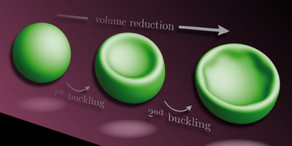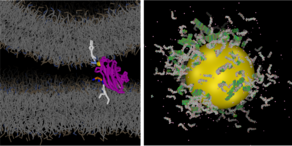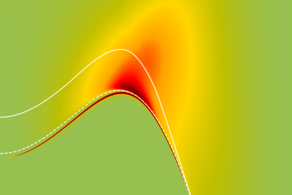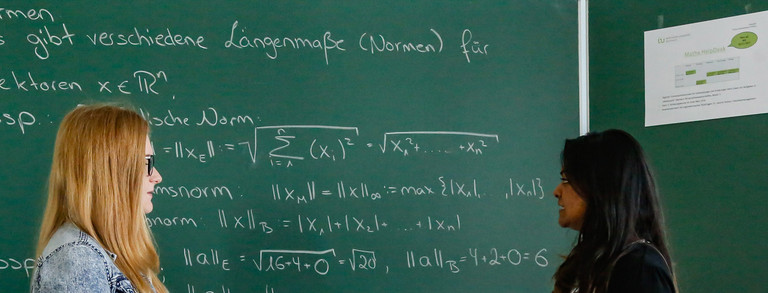Topics Offered for Bachelor Theses
Our research group is constantly offering theses on the Bachelor level. On the Bachelor level, the topics are close to known results in scientific literature. Of course, she or he will be constantly supervised and supported in this endeavor by the head of the group and the other members of the research group!
For this reason, the possible topics are constantly evolving and no specific problems can be given here. Students interested in a Bachelor theses get a flavor of possible topics by the list given in list below. The presentation of the research group (in German) indicates useful capabilities for doing theoretical research which may offer some guidance.
Possible Topics
Besides analytical methods, numerical methods are essential in modern physics. In condensed matter theory, density matrix renormalization is a very powerful method, established by Steven R. White, and tailored to essentially one-dimensional systems.
If one wants to completely describe a quantum mechanical system, one way is to determine all the eigenvalues. But this is only possible for very small systems by means of the so-called Exact Diagonalization. If one wants to proceed to larger systems, one possible approach is to omit a large part of the Hilbert space in order to keep a simple, i.e., sufficiently small, system. But in doing so, only the smallest possible error in the wanted observables should be made. So which states are most likely to be omitted? This can be decided with the help of the eigenvalues of a density matrix.
The goal of the bachelor thesis is to reproduce the above sketched train of thought in detail. Diagonalization and density matrix renormalization will be illustrated by simple examples.
- S. R. White
Density Matrix Formulation for Quantum Renormalization Groups
Physical Review Letters 69, 2863 (1992) - S. R. White
Density-Matrix Algorithms for Quantum Renormalisation Groups
Physical Review B 48, 10345 (1993) - R. Noack und S. White
The Density Matrix Renormalization Group (zur Ausleihe/Ansicht vorhanden)
Kapitel 2 in "Density-Matrix Renormalization", Herausgeber Ingo Peschel, Xiaoqun Wang, Matthias Kaulke und Karen Hallberg
Springer Lecture Notes in Physics 528 (1998)
In the theoretical description, control pulses are terms in the Hamiltonian operator that are temporarily added. They are used to selectively influence the state of a quantum mechanical system. Here we consider a spin S=1/2 (NMR) or a so-called quantum bit or short qubit (quantum information).
In practice, it is never only the control pulse which influences the qubit, but also unwanted, but unavoidable interactions with the environment. By clever choices of the pulse shape, e.g., an amplitude as a function of time v(t), one can mitigate the effect of the environment. We have established equations that describe when a pulse is optimal in this sense.
The goal of the bacheolor work is to evaluate these equations explicitly for different pulses or pulse trains and to search for favorable pulse protocols. Technically, this requires one- and two-dimensional integrations, some of which can be solved efficiently with computer algebra programs and some with numerical programs.
- S. Pasini, T. Fischer, P. Karbach, und G. S. Uhrig
Optimization of short coherent control pulses
Physical Review A 77, 032315 (2008) - S. Pasini, P. Karbach, C. Raas und G. S. Uhrig
Optimized pulses for the perturbative decoupling of spin and decoherence bath
Physical Review A 80, 022328 (2009)
By a clever choice of basis one can simplify quantum mechanical problems very much. A particularly elegant method for this is based on continuous unitary transformations (CUTs). A CUT corresponds to a rotation which is parametrized by a continuous variable. An important point is how one rotates, i.e. which axes of rotation one uses. For Hamiltonian operators the axis of rotation is called "generator".
Technically, one has to calculate a commutator and solve a differential equation system of O(10) variables. The latter can be done with any computer algebra program such as Maple or Mathematica. From quantum mechanics, one should know what a ground state is and a creation and annihilation operator of an energy quantum in a harmonic oscillator.
Then, the goal is to describe not only a harmonic potential but also a quartic potential which has a distinct double trough shape (like a W). In doing so, different generators can be tried out and compared which are also relevant for applications in research.
- S. Dusuel und G. S. Uhrig
The Quartic Oscillator: A Non-Perturbative Study by Continuous Unitary Transformations
Journal of Physics A 37, 9275 (2004)
Coherent control of quantum systems is essential in many experiments, e.g., for high precision nuclear spin resonance or quantum information processing. There are many proposals for the optimization of coherent control, but they need to be verified on simple models before experimental realization. For this purpose, the time evolution of correlated systems is needed, e.g., of some O(5) spins.
The aim of the Bacheolor work is to calculate the time evolution of such systems from a few spins. For this purpose, a basis is chosen and one considers by which matrix the Hamiltonian operator is represented in the chosen basis. This matrix is numerically diagonalized using known implemented algorithms (in Matlab, Maple, Mathematica, Python or C). In this manner, the time-dependent Schrödinger equation is solved.
An alternative approach to temporal evolution is the so called Chebyshev expansion. The iterated application of the Hamilton operator to a single state vector allows one to determine expansion coefficients which in turn determine the time evolution up to a certain threshold time tmax.
- G. S. Uhrig
Keeping a Quantum Bit Alive by Optimized π-Pulse Sequences
Physical Review Letters 98, 100504 (2007) - P. Karbach, S. Pasini und G. S. Uhrig
Numerical analysis of optimized coherent control pulses
Physical Review A 78, 022315 (2008)
Simulations consist in reproducing physical events directly in the computer. Monte Carlo simulations achieve this by statistical methods. A standard application is the description of continuous phase transitions. The simplest model to do so is the Ising model.
The aim of the bachelor thesis is to statistically simulate the Ising model in one and two dimensions. Some properties are to be determined as a function of temperature, for example the internal energy or the specific heat. It is interesting to characterize the phase transition by determining the transition temperature and critical exponents. The self-obtained results are to be compared with the exactly known results.
- Werner Krauth
Statistical Mechanics: Algorithms and Computations (zur Ausleihe/Ansicht vorhanden)
Oxford Master Series in Statistical, Computational, and Theoretical Physics
Oxford University Press, 2006
Topological effects have entered condensed matter physics at least since the 2016 Nobel Prize to David Thouless, Duncan Haldane and Michael Kosterlitz, and promise novel transport phenomena with reduced dissipation, i.e. less resistive losses, which can enable more sustainable information processing in the longer term. Microscopically, spin-orbit coupling is the origin of topological twists in electronic quantum systems and thus in systems of localized electronic spins.
The aim of the bachelor thesis is to reproduce how a spin-orbit coupling leads to the asymmetric spin-spin couplings and to compute an ensuing effect such as the topological Zak phase and/or the formation of localized edge states.







